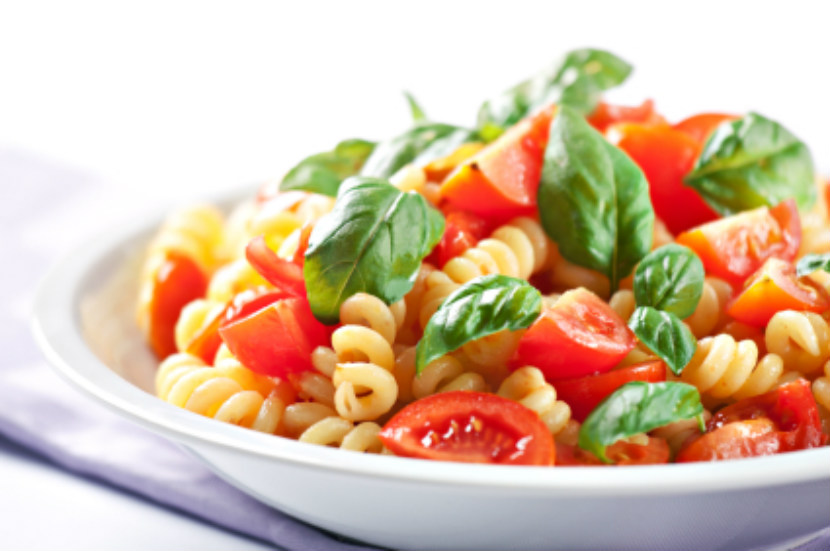
If you enjoy pasta, learn to make tasty and nutritious dishes at home. Cooking pasta dishes in your own kitchen lets you limit the amount of fat and salt that goes into your dish and lets you control your serving size too.
What is pasta?
The word “pasta” refers to noodles made from semolina, a type of wheat flour. Pasta can be either dried or fresh.
-
Dried pasta is inexpensive, comes in many shapes and stores well for long periods of time.
-
Fresh pasta is made with egg and must be kept in the fridge and used within a few days.
Pasta is good for you
Pasta provides energy from carbohydrates. It does not cause big fluctuations in blood glucose levels because it has a low glycemic index (GI) value. GI rates the effect of foods on blood glucose levels. Pasta has a lower GI than bread or rice.
Pasta is also fat-free, low in sodium and is often enriched with:
-
Thiamine (vitamin B1)
-
Riboflavin (vitamin B2)
-
Niacin (vitamin B3)
-
Folic acid
-
Iron
Tip: Not all pasta is enriched. Noodles that are imported may or may not contain added vitamins and minerals. Read the package to see if nutrients have been added.
Look for fibre-rich pasta
Pasta made from refined semolina is typically low in fibre. For a fibre boost, look for noodles made from:
-
Whole grain durum wheat semolina
-
Whole grain rye
-
Brown rice
-
Buckwheat (soba)
-
Whole grain kamut
-
Quinoa
Cook it up! Here are four steps for making a healthy pasta dish:
1. Pick your noodle
Opt for enriched pasta made from whole grain flour. The shape you choose is up to you!
2. Boil
Bring water to a boil in a large pot. Add pasta and cook according to package directions. Do not add salt to the water. It increases sodium content and makes it take longer for the water to boil.
Tip: Cook until “al dente” or slightly firm and chewy. Overcooking pasta raises its GI value.
3. Top it
Remove pasta from boiling water with tongs or drain in a colander. Put it in a bowl and pick your sauce.
For maximum nutrition with the least fat and calories, pick tomato sauce. It is a source of vitamins A and C and the antioxidant lycopene. A drizzle of olive oil with fresh herbs is another good option.
Some commercial tomato sauces are high in sodium. Read nutrition labels and choose a sauce with 360 mg of sodium or less per half-cup. Creamy Alfredo or cheddar cheese sauce has more calories and fat than tomato sauce. And savoury sauces like pesto can be very high in sodium -- about 1100 mg per half-cup.
Tip: Use light sauces for delicate pastas like angel hair. Chunky sauces such as ratatouille work best for sturdy pasta like fusilli.
4. Serve
According to Canada’s Food Guide, one serving of pasta is ½ cup. Most restaurant portions are much larger! Cooked pasta contains about 230 calories per cup. This adds up quickly if your portion size if too large or if you add meat or cream sauce. A sensible serving of pasta is ½ a cup (side dish) to 1½ cups (main meal).
Make it a meal - Mix and match your pasta noodle, pasta sauce and toppings
Pasta with tomato sauce or herbs and olive oil is a lovely side dish. If you want to turn pasta into a meal, try one of these tasty creations:
|
Name
|
Pasta
|
Protein
|
Vegetables
|
Sauce
|
Topping
|
|
Spaghetti with spicy tuna
|
Linguine
|
Lower sodium canned tuna
|
Roasted cherry tomatoes, red onion
|
Olive oil, chili flakes
|
Fresh parsley
|
|
Hearty ratatouille
|
Rotini
|
Chicken
|
Eggplant, zucchini, mushroom, onion
|
Tomato sauce
|
Oregano, parmesan cheese
|
|
Shrimp and mango pasta salad
|
Spaghetti
|
Grilled shrimp
|
Red and green peppers, jalapeno peppers, red onion
|
Mango salsa: mango, onion, lime, olive oil
|
Cilantro
|
|
Pad Thai
|
Brown rice noodles
|
Tofu
|
Broccoli, baby corn, red pepper, garlic, bean sprouts, cilantro
|
Peanut butter, rice vinegar, hot sauce, canola oil, dash of fish sauce
|
Green onions, peanuts
|
|
Pasta primavera
|
Rye spirals
|
Edamame
|
Snow peas, broccoli, carrots, celery, red peppers
|
Tomato sauce, fresh basil
|
Fresh basil, grated Asiago cheese
|
Tip: When using grated cheese as a garnish, a tablespoon is all you need. When using oil, remember that a teaspoon or two is all you need to enhance 1 cup (250 mL) of pasta.
Bottom line when making a pasta dish:
With unlimited recipe ideas and lots of nutritional value, pasta is an exciting and healthy choice. Plain pasta is fat-free and low in sodium. However, once you add sauce, you also add salt and fat. Choose tomato sauce most often. Adding protein and vegetables turns pasta from a side dish into a meal, but you need to watch your portion size.
Pasta recipes
Mac and squeeze
Vermicelli with Broccoli and Grilled Beef
Spinach and mushroom lasagna
You may also be interested in
How to choose the best pasta sauce
How to choose the best pasta
Last Update – May 5, 2017